Welcome to Xinjiang, a land of awe-inspiring beauty and boundless diversity. This vast region, which covers one-sixth of China’s total land area, offers a rich tapestry of natural wonders and cultural treasures. From snow-capped mountains to lush meadows, pristine lakes, winding rivers, deep forests, and dramatic canyons, Xinjiang’s landscapes are as diverse as they are breathtaking. In this blog, we will take you on a virtual journey to explore some of Xinjiang’s most captivating attractions. Whether you’re an adventurer, nature enthusiast, or culture seeker, Xinjiang has something to fulfill your every fantasy of natural beauty.
Ürümqi
As the capital of Xinjiang, Ürümqi stands as the heart of this region, a melting pot of traditions, cultures, delectable cuisines, and customs from across Xinjiang.
1. Xinjiang International Grand Bazaar

Established on June 26, 2003, the Xinjiang International Grand Bazaar stands as the world’s largest bazaar, seamlessly blending Islamic culture, architecture, ethnic commerce, entertainment, and culinary experiences. It serves as a focal point for Xinjiang’s tourism and a window to Xinjiang, Central Asia, and the world.
In 2004, it was named one of Ürümqi’s “Top Ten Buildings.” The bazaar boasts a rich Islamic architectural style that not only fulfills its functional purpose but also recreates the prosperity of the ancient Silk Road, showcasing the distinct ethnic characteristics and regional culture of Xinjiang.
2. Xinjiang Uygur Autonomous Region Museum

This museum showcases Xinjiang’s history and the customs of its various ethnic groups. It also features rare exhibits, including the “Beauty of Loulan” ancient mummy and the Han Dynasty woven silk known as “Five Stars Over the East.” The museum is a must-visit attraction in Ürümqi.
The museum is a modern three-story building that incorporates Xinjiang’s architectural styles such as arched windows and domed roofs, adding a unique touch. The first floor houses exhibitions on Xinjiang’s ethnic culture and ancient historical artifacts. On the second floor, you’ll find displays of historical textiles and a themed exhibition titled “Forever with Our Motherland.” The second floor also features exhibits on ancient mummies and white jade.
3. Tianshan Grand Canyon

Tianshan Grand Canyon is a natural scenic area that combines snow-capped mountains, forests, lakes, and grasslands. Each season offers a unique and breathtaking view, with the autumn canyon donning vibrant colors like a rainbow, while the winter transforms it into a pristine snow-white wonderland.
Tianshan Grand Canyon is home to the most intact and visually stunning original spruce forests on the northern slopes of the Tianshan Mountains. It encompasses all of Xinjiang’s natural landscapes, except deserts, making it a living museum of nomadic culture that predates human agrarian civilization.
4. Hongshan Park

With an elevation of 910.6 meters, Hongshan, meaning “Red Mountain” in Chinese, derives its name from the reddish-purple conglomerate rock that forms the mountain. Standing atop Hongshan offers panoramic views of Ürümqi, making it a must-visit attraction for both domestic and international tourists.
Hongshan Park is a natural mountain park characterized by its classical features. It resembles a resting dragon, lying horizontally from east to west, with its lofty head reaching the Ürümqi River. The park symbolizes Ürümqi and is a prominent landmark of the city.
5. Xinjiang Ancient Ecological Park

Xinjiang Ancient Ecological Park aims to protect the irreplaceable ancient biological species of Xinjiang in an alternate location, developing and promoting Xinjiang’s ancient ecological culture. It gathers the unique ancient biological species from Xinjiang’s “Three Mountains and Two Basins” geological landscapes and protects them. Using garden artistry, it maximizes the recreation of nature and replays the pristine aspects of nature, rekindling the ancient Silk Road civilization and showcasing the unique culture of the Western Regions.
Within Xinjiang Ancient Ecological Park, you’ll find China’s largest blood-sweating horse display base, the Wild Horse Art Museum featuring oil paintings by domestic and international masters, the Jurassic silicified wood preservation base, the Silk Road Science Museum, the Silk Road Historical Figures Memorial Hall, and the Silk Road Art Boutique Museum. It combines ecological tourism, cultural tracing, and folk experiences, uniting the rare natural treasures of the Western Regions with the essence of ancient and modern Silk Road cultures.
Altai Region
The Altai Region, located in the northern part of Xinjiang, borders Russia, Kazakhstan, and Mongolia, with a border length of 1,197 kilometers. It is one of Xinjiang’s key tourist destinations.
6. Kanas Scenic Area

Kanas presents a different facet in every season. Spring blankets Kanas with a riot of colorful flowers and lush grass. Summer paints the landscape with vibrant shades of green, reflecting in the rippling lake. Autumn adorns Kanas with a myriad of colors, and the water takes on a deep jade hue. Winter drapes Kanas in a shimmering white cloak, creating an ice-cold wonderland. Kanas’s beauty evolves with the changing climate throughout the year.
The Kanas Scenic Area encompasses Kanas National Nature Reserve, Baihaba National Forest Park, Jiadengyu National Forest Park, Buerjin Valley, Hemu Valley, Hemu Grassland, and the villages of Hemu, Baihaba, and Kanas. It offers both natural and cultural attractions.
7. Hemu Scenic Area

Located approximately 30 kilometers east of Kanas Lake in Burqin County, Altai, Hemu is a village inhabited by Kazakhs and Tuwas. Tourists often visit Hemu Village alongside the Kanas Lake Scenic Area when exploring Northern Xinjiang.
Hemu Village features simple wooden houses scattered amidst the valleys and mountains. The Hemu River flows gently by, its waters a clear shade of light blue. Surrounding the village are grasslands and birch forests, creating a picturesque landscape. During winter, the mountain peaks are covered in snow, resembling a scene from a fairy tale.
8. Koktokay Scenic Area

Koktokay, known as the “World Geological and Mineral Museum,” boasts natural wonders like single-rock mountains, the world’s most intact seismic fault zone, and the largest mine pit globally.
The scenic area comprises the Karasu-Xing’er Fault Zone, Koktokay, Iremul Lake, and the Irtysh Grand Canyon. It seamlessly integrates beautiful canyon river sources, wetland landscapes, extreme cold lakes, geological mineral resources, and more. It also showcases grassland nomadic culture, Western ethnic customs, and regional folk traditions.
9. Five-Colored Beach
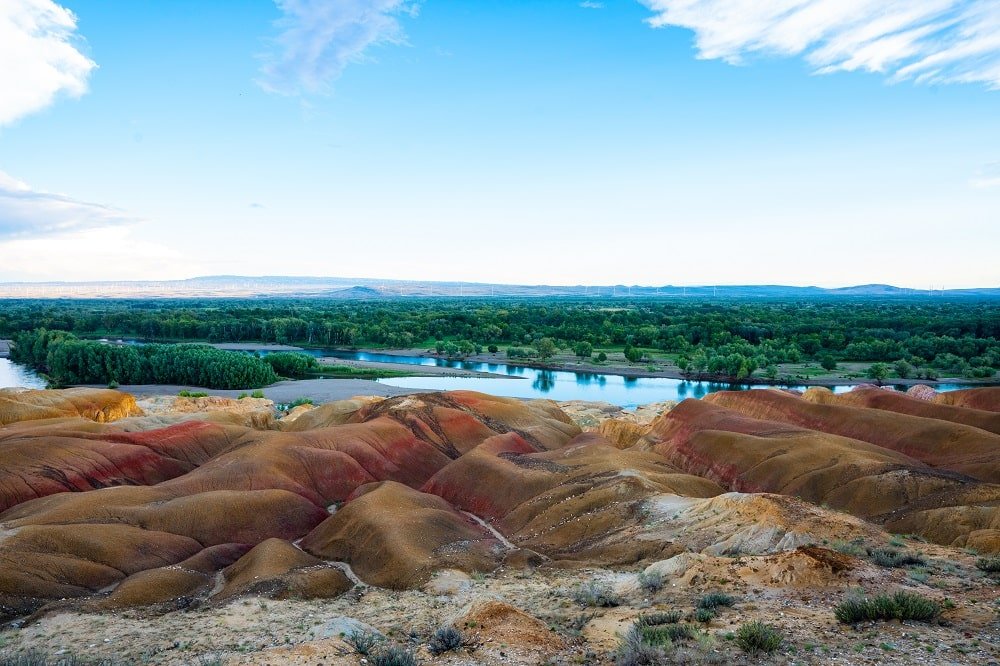
The unique landscape of the Five-Colored Beach resides in a dry region. It’s a typical colorful hilly landform. Adjacent to the rippling Irtysh River with its lush green valleys on the other side, it’s a juxtaposition of fiery red yardang landforms against the lush river valley, creating a striking contrast. The rock layers along the riverbank have different weathering resistance, and the rocks contain various minerals, resulting in a multitude of vibrant colors, hence the name “Five-Colored Beach.”
10. General Mountain International Ski Resort

Altai’s location along the world’s skiing golden latitude has earned it the title of “China’s Snow Capital.” The effective snow season lasts from late October to early April of the following year, with abundant natural snowfall. The snow quality is primarily dry powder, making it ideal for skiing.
Currently, General Mountain boasts 58 ski runs with a ratio of 3:4:3 for beginners, intermediates, and advanced skiers. It has also developed various terrains, including the BK Ski Park, Xinliu Full Line Park, Mini Park, and Amateur U-shaped Pool, catering to the needs of skiers of all levels.
Ili
Until you’ve been to Xinjiang, you can’t fathom China’s vastness. Until you’ve been to Ili, you can’t comprehend Xinjiang’s beauty. These sentiments are echoed by anyone who has set foot in Ili.
11. Narat Grassland
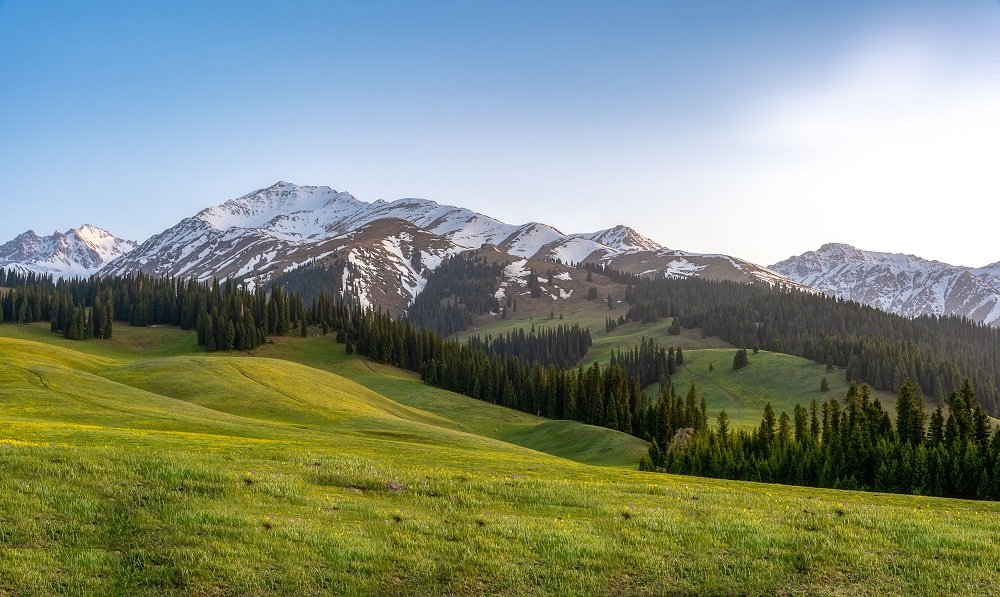
Narat Grassland is one of the world’s four major high-mountain river valley grasslands. Here, the blue sky, glaciers, snow-capped peaks, forests, meadows, and winding rivers converge. It’s home to the most concentrated population of Kazakhs in the world, often referred to as an “open-air museum” showcasing traditional Kazakh life.
April to June is the best time to visit Narat Grassland, with wild lilies blooming from early April to late June, painting the sky meadows like a blossoming garden. July to September sees lush greenery and is perfect for a cool summer retreat. October to November transforms Narat into a paradise for photographers with its colorful landscapes. From December to March, Narat turns into a pristine white wonderland.
12. Kalajun Grassland
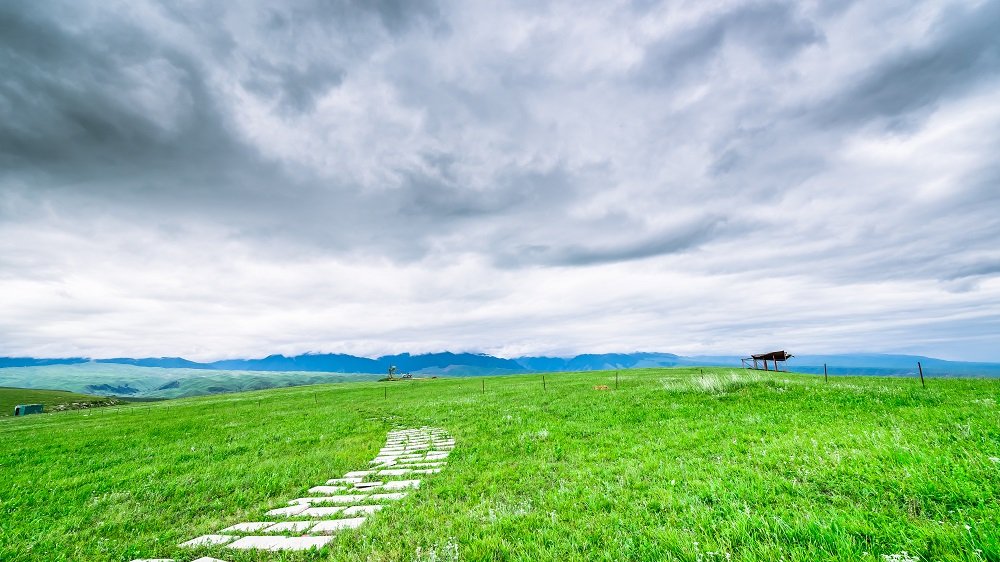
Located in the southeast of Tekes County, Ili, Kalajun Scenic Area is one of Xinjiang’s most renowned grasslands and a must-visit attraction on the Xinjiang Western Loop tour. Kalajun’s undulating hills are backed by majestic snow-capped mountains, and the area features forests, flower seas, and breathtaking landscapes, making it an ideal destination for sightseeing and photography.
Kalajun Grassland is divided into East and West sections. East Kalajun, nestled deep within the scenic area, is the most picturesque part of the grassland. Here, you’ll find a diverse range of landscapes, from alpine meadows to forests and canyons, offering stunning natural beauty. West Kalajun, characterized by rolling hills, is famous for its hilly grassland landscapes. Shaped like waves, it’s especially captivating during the summer months when the meadows are lush and vibrant.
13. Kuoksu Grand Canyon

Originating in the middle of the Tianshan Mountains, Kuoksu Grand Canyon was formed by geological movements and the interaction of glacial meltwater from the Tianshan Mountains over millions of years. Located in the southern part of Tekes County, Ili, this canyon boasts stunning natural landscapes, including the Hukou Waterfall, Nine Bends, and Crocodile Bay.
Within the Kuoksu Grand Canyon, the picturesque Kuoksu River meanders through steep, precipitous cliffs and valleys. Surrounded by towering peaks, lush vegetation, and wisps of smoke from the yurts of nomadic herdsmen, it’s a magnificent yet enchanting grassland gorge.
14. Xiata Tourist Area

Xiata Tourist Area, situated in Wenhua Street, Zhaosu County, Ili Kazakh Autonomous Prefecture, is a unique cultural and tourist area featuring the Xiata River and Tekes River region. Spanning 120 kilometers in length, this area is abundant in natural landscapes, ancient roads, historical sites, folk customs, and cultural attractions. Highlights include Xiata Ancient City, Xiata Ancient Road, grassland pastoral routes, rock figures on the grassland, and the Wusun Ancient Tomb Group.
15. Qiongkushitai
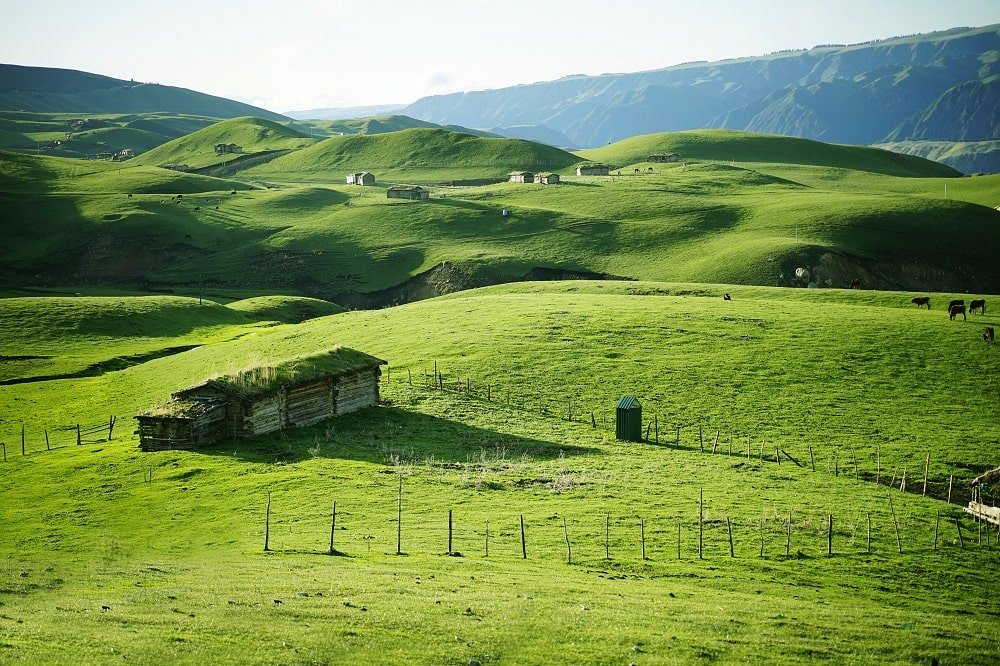
The most beautiful landscapes are often hidden in hard-to-reach places, and Qiongkushitai is no exception. It may not be as famous as Narat Grassland, Kalajun Grassland, or Bayanbulak Grassland, but the scenery along the road from Tekes County to Qiongkushitai is like opening a surprise blind box.
Qiongkushitai, in Kazakh, means “large plateau.” It features rugged terrain with numerous ravines, imparting a robust and masculine beauty to the grassland. Countless gullies crisscross the plateau, creating a landscape reminiscent of ocean waves on a tranquil prairie.
Turpan
Turpan, a shining pearl along the ancient Silk Road, has been a hub where four great civilizations intersected since ancient times. It was once the political, economic, and cultural center of the Western Regions.
16. Flaming Mountains
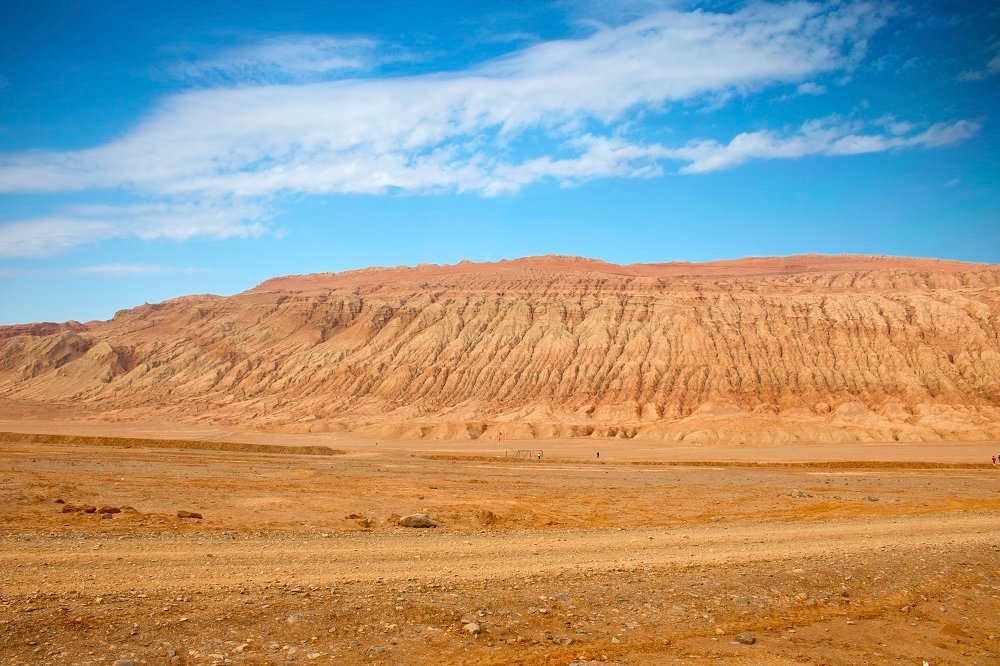
The Flaming Mountains Scenic Area primarily features striking reddish-brown sandstone landscapes. Historically, this area was the heartland of the Gaochang Kingdom and the location of the “Flaming Mountains” described in the classic Chinese novel “Journey to the West,” where Tang Sanzang and his disciples used a banana leaf fan to extinguish a great fire. It’s a must-visit destination for many tourists exploring Turpan.
The Flaming Mountains Scenic Area is divided into two parts: underground and aboveground. The underground section is a gallery-style exhibition hall featuring statues and exhibits related to the Gaochang Kingdom, providing insights into its history.
The aboveground section boasts the awe-inspiring fiery rocks and cliffs, making it an excellent spot for photography. The square at the surface features sculptures themed around “Journey to the West” and a giant thermometer known as the “Golden Hooped Rod.”
During the summer, the Flaming Mountains can get exceptionally hot, with temperatures reaching up to 58 degrees Celsius (136 degrees Fahrenheit). The climate is also extremely dry. Visiting during this time offers a unique experience, but it’s essential to bring plenty of water and prepare sun protection gear such as hats, sunglasses, and scarves to avoid heatstroke.
17. Grape Valley Scenic Area
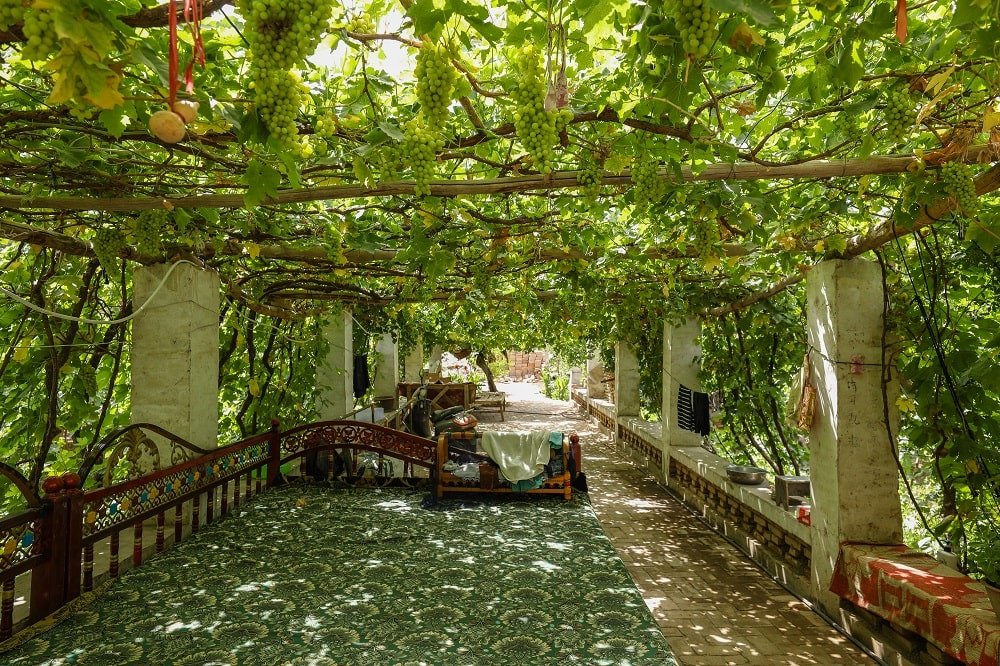
Grape Valley is located 11 kilometers northeast of Turpan City in Xinjiang. It’s a gorge nestled beneath the Flaming Mountains, with the Buieruke River flowing through it. Fed by melting snow from the high mountains, this area is famous for its abundant grape production and is a popular tourist destination in Turpan.
Here, you can experience the magical wonders of nature, taste some of the sweetest grapes in the world, enjoy passionate Uighur dances, witness thrilling performances like the “Dawazi,” and take part in lively grape-picking festivities.
18. Kumtag Desert

The Kumtag Desert is situated on the eastern edge of the Turpan Basin, about 90 kilometers (56 miles) from Turpan City. It’s a mobile desert with numerous sand dunes and hills, offering diverse and spectacular landscapes. For most tourists, visiting the Kumtag Desert typically means going to the Sand Hill Park (Kumtag Desert Park) south of Turpan City, as it provides convenient access to the desert. The park offers a range of entertainment options, including sand sledding and desert off-road vehicle tours, available for a fee. It’s recommended to plan for 3-4 hours when visiting.
For adventure enthusiasts or hikers, there are also two trekking routes within the Kumtag Desert. One is from the Sand Hill Park to Lanqiang Township, which is approximately 10 kilometers (6 miles) and can be completed in a day. The other route involves crossing from the Sand Hill Park to Dikan’er Village in the southwest of the desert, covering a distance of over 40 kilometers (25 miles) and requiring around 3 days to complete. These treks are more challenging and not suitable for inexperienced hikers. It’s advisable for outdoor enthusiasts to join a professional team and come well-prepared with desert trekking equipment.
19. Kanerjing Folk Park

Kanerjing Folk Park, located to the east of Turpan City, is a themed attraction showcasing the culture of Kanerjing. The park features a replica of Kanerjing and a museum where you can gain a systematic understanding of Kanerjing culture. You can also dine and stay in Uighur-style accommodations within the park, experiencing the architecture and cuisine of the Uighur people. It’s a great place for tourists to explore while visiting Turpan.
Kanerjing Folk Park is relatively small, with a length and width of only a few hundred meters. Visitors can explore the park on foot, taking approximately 2 hours for a quick visit. Some tourists choose to spend a night within the park to experience Uighur-style living.
20. Jiaohe Ancient City

Jiaohe Ancient City, an important archaeological site, bears witness to over 2,000 years of history along the Silk Road. This ancient city is known for its well-preserved earthen structures and is one of the world’s oldest and best-preserved earthen cities. With its historical significance, it offers valuable insights into the civilization and history of the region. Jiaohe was a vital political, economic, military, cultural, and agricultural center in the ancient Western Regions of China.
Kashgar
People often say, “In Northern Xinjiang, you appreciate the scenery; in Southern Xinjiang, you explore the culture.” The cultural richness here refers mainly to the Uighur culture in Kashgar Old City and the Tajik culture in Tashkurgan County. Most tourists come here seeking these two vastly different cultural experiences.
21. Kashgar Old City
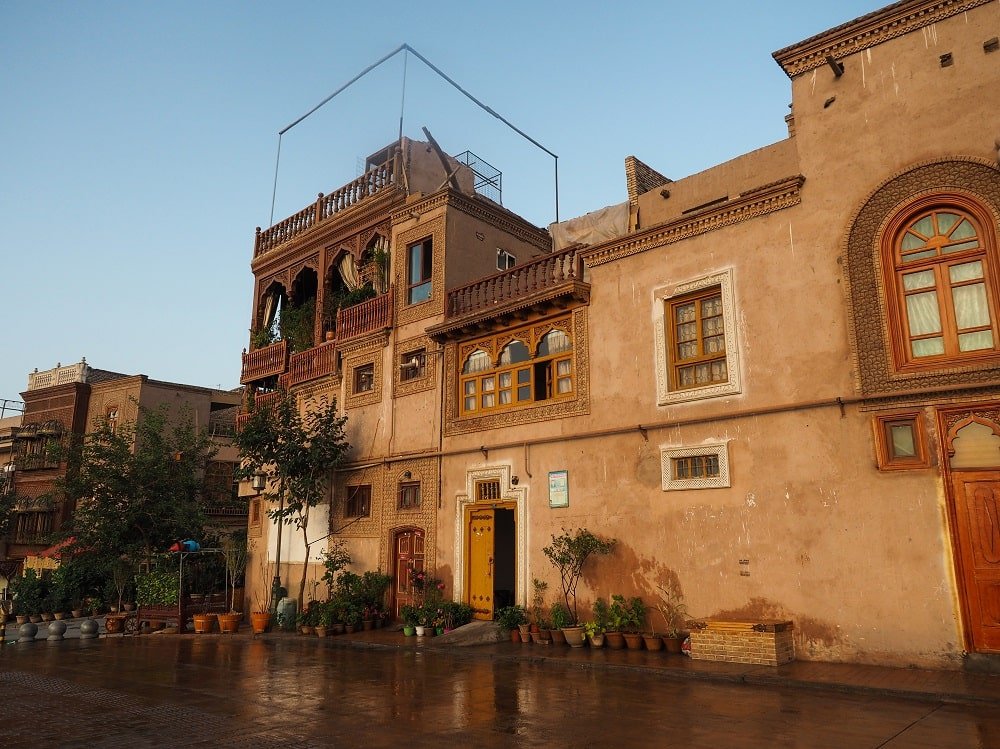
Kashgar Old City boasts a long history, rich culture, and unique charm, earning it the reputation of “You haven’t been to Xinjiang until you’ve been to Kashgar, and you haven’t been to Kashgar until you’ve been to the Old City.” As a radiant gem on the ancient Silk Road, where Eastern and Western civilizations converge, Kashgar Old City now radiates new charm with its open and inclusive spirit.
Exploring Kashgar Old City involves savoring the distinctive architecture and streetscape. Here, you’ll find colorful mud and brick walls adorned with special decorations like round arches and colorful doors and windows, making it a fantastic place for photography. If you want to experience even more authentic architectural features, consider visiting the high platform residences on the east side of the Old City, near the riverbank.
22. Pamir Plateau

The Pamir Plateau, located in the southeastern part of Central Asia, spans Tajikistan, China, and Afghanistan. “Pamir” means “roof of the world” in Tajik, and this high plateau ranges from 4,000 meters to 7,700 meters in elevation, featuring numerous peaks.
The Pamir Plateau is often referred to as the “roof of the world” and is a destination that captures the imagination of travelers. Surrounded by towering mountains, this high-altitude region offers magnificent natural landscapes, diverse wildlife, and a profound human history, attracting countless adventurers and travel enthusiasts.
23. Fragrant Concubine Garden
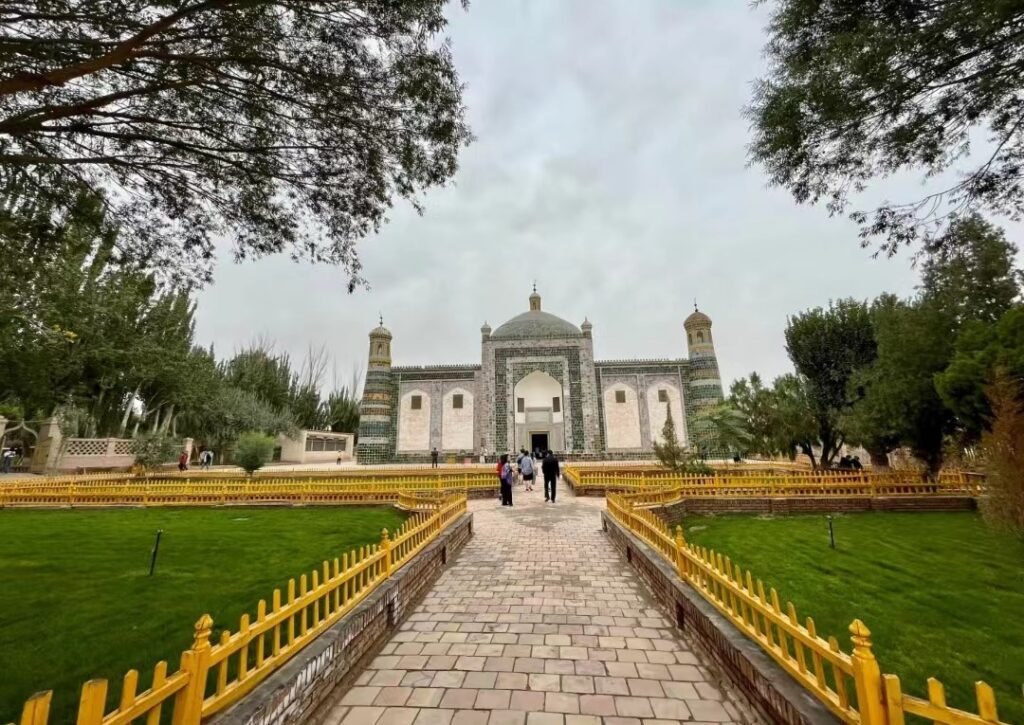
The Fragrant Concubine Garden is situated to the east of Kashgar city center. It was originally established in 1640 and was designated as a key cultural heritage site in 1988. Starting in 2014, the area underwent significant renovations and expansion, increasing its size from 70 mu (about 4.67 hectares) to over 300 mu (approximately 20 hectares). The architectural style primarily combines ethnic features with modern elements.
The central theme of the garden revolves around the story of Emperor Qianlong and the Fragrant Concubine. It tightly aligns with the theme of ethnic unity, showcasing the rich history of Kashgar and the continuous cultural exchange and integration among various ethnic groups in Xinjiang. The garden has been a testament to the fascinating stories of Kashgar, where different ethnicities have interacted and blended since ancient times.
24. Id Kah Mosque

Id Kah Mosque is a courtyard-style mosque, and its main entrance on the east side opens onto the expansive Id Kah Square, which serves as a prominent symbol of Kashgar. “Id Kah” in Uighur language translates to “festival” or “joyful square.” The mosque is a sacred place for Muslims to conduct religious activities and prayers.
Located west of Id Kah Square in the heart of Kashgar city, the Id Kah Mosque covers an area of 16,800 square meters. It was originally constructed in 1442 and has a history spanning over 500 years. Id Kah Mosque is not only the largest mosque in Xinjiang but also one of the largest in China and among the three most influential mosques in Asia.
25. Jinhuyang National Forest Park

Jinhuyang National Forest Park is located approximately 36 kilometers southwest of Ze Pu County within the Yasi Dun Forest Farm. It covers an expansive area of 40,000 mu (about 2,667 hectares), with a natural Populus euphratica (commonly known as Euphrates poplar) forest covering an impressive 20,000 mu (around 1,333 hectares). The best time to visit this park is during the autumn when the leaves of the Populus euphratica turn a vibrant yellow.
The unique natural landscape of Jinhuyang National Forest Park combines the vast Populus euphratica forest with the open Yarkand River and the flat, barren Gobi Desert on both sides of the riverbank. This harmonious blend of Populus euphratica trees, water, oasis, and desert showcases a picturesque scene that is rarely found on the western edge of the Tarim Basin, making it a remarkable tourist destination.
Bayingolin
Bayingolin, located in the southeastern part of Xinjiang, is the largest autonomous prefecture in terms of administrative area among the 30 ethnic minority autonomous prefectures in China. It is often referred to as the “First Prefecture of China.”
26. Bayanbulak Grassland
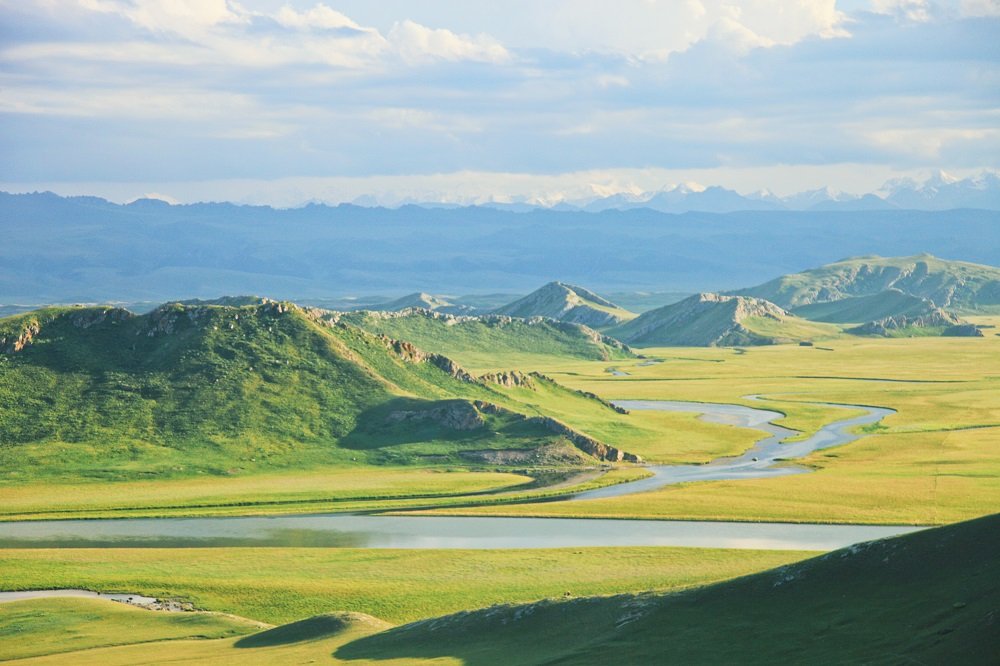
The Bayanbulak Grassland is characterized by its flat terrain and abundant water and grass, making it a typical meadow grassland and one of the most important livestock breeding bases in Xinjiang. It is a natural scenic area that combines mountains, basins, and grasslands. With an average elevation of 2,400 meters, it covers a total area of approximately 1,100 square kilometers, making it the second-largest grassland in China.
Due to minimal human interference, the Bayanbulak Grassland is home to various rare species, making it an ideal breeding and habitat area for wildlife such as swans. Preliminary records show that the Bayanbulak Scenic Area is home to 704 species of wild vascular plants from 254 genera in 62 families.
27. Tarim Populus Euphratica Forest Park

The Tarim Populus Euphratica Forest National Forest Park covers a total area of 100 square kilometers, making it the largest primitive Populus euphratica forest park in Xinjiang. It is located in the middle reaches of the Tarim River, on the northeastern edge of the Taklimakan Desert, approximately 70 kilometers south of the county seat of Luntai in Bayingolin Prefecture.
The Tarim Populus Euphratica Forest National Forest Park combines natural landscapes such as the Tarim River, Populus euphratica forests, desert scenery, and the petroleum industry. It serves as a natural scenic destination for sightseeing, leisure, outdoor adventures, and scientific exploration.
28. Loulan Ancient City

The world-renowned historical site of Loulan Ancient City is situated in the western part of the Lop Nor, an area that held a crucial position along the ancient Silk Road. According to historical records in “Records of the Grand Historian: Biography of Dayuan” and “The Book of Han,” Loulan was a well-known “walled kingdom” in the Western Regions as early as the 2nd century BCE.
Loulan, an ancient kingdom founded in 176 BCE, mysteriously disappeared in 630 CE. The ruins of Loulan present a desolate and melancholic scene, with dilapidated structures lacking vitality, evoking endless imagination among later generations.
29. Jiuqushibawan (Nine Bends and Eighteen Curves)

“Jiuqushibawan,” which translates to “Nine Bends and Eighteen Curves,” refers to the winding course of the Kaidu River on the grassland. Looking up, you’ll see dense and vibrant pine trees covering the mountains, creating layers of green like ink painting. The undulating peaks resemble waves, and the rustling of the pine trees sounds like a galloping herd of horses. From above, this picturesque landscape appears like an oil painting. The winding and rugged river, known as Kaidu River, meanders forward like a dragon. The lush willow trees along the banks add to the beauty.
Wild ducks playfully fly across the sky, and various birds sing in the mountains, creating a sense of wonder. Especially in the morning or after rain, with lingering mist and morning fog, you’ll feel like you’re walking on clouds, as if on a celestial journey.
30. Lop Nor

Lop Nor, located in the southeastern part of the Xinjiang Uygur Autonomous Region, is often referred to as the “Ear of the Earth” due to its shape resembling a human ear. It is also known as the “Sea of Death.”
In the mid to late 20th century, due to a decrease in the flow of the Tarim River, the surrounding area experienced severe desertification, eventually completely drying up by the late 1970s (before the 1970s, it was the second-largest saltwater lake in China).
However, today’s Lop Nor is not entirely barren. It is home to Populus euphratica trees, reeds, and licorice, as well as wildlife like wild camels, maral deer, and wild boars. Over the past two thousand years, many explorers from both China and abroad have visited Lop Nor. If you’re an adventurous traveler, Lop Nor is a destination you shouldn’t miss.
Changji Hui Autonomous Prefecture
The beauty of Changji is diverse, featuring snow-capped mountains, grasslands, lakes, rivers, dense forests, and canyons, fulfilling all your fantasies of natural landscapes.
31. Tianshan Tianchi

Tianshan Tianchi, or Heavenly Lake, is a must-visit destination for travelers in Xinjiang, China. The Tianshan Tianchi Scenic Area is centered around the Heavenly Lake and features four distinct vertical natural landscapes, including glaciers, high mountain lakes, forests, and meadows. It is rich in culture, with connections to ancient Yaochi Xiwangmu mythology, religion, and unique ethnic customs. This area offers a unique blend of forests, meadows, snowy mountains, and cultural landscapes, making it a truly picturesque destination.
Tianshan Tianchi is also recognized as a UNESCO World Natural Heritage site, an International Man and Biosphere Reserve, one of China’s best tourist destinations, one of China’s top ten scenic spots for resource protection, and one of China’s top ten charming leisure lakes.
32. Tianshan Tianchi International Ski Resort

The Tianshan Tianchi Ski Resort is located at the foot of the Tianshan Mountains within the Tianshan Tianchi Scenic Area. It benefits from an advantageous geographical location and convenient transportation. The resort boasts China’s largest ski equipment hall and features a total of seven ski slopes, including dedicated slopes for children, beginners, intermediates, and advanced skiers. There are also top-notch cross-country ski trails and a snowboarding U-shaped pool.
In addition to skiing, the resort offers a wide range of entertainment activities, including paragliding, hot air ballooning, karting, archery, and an ice paradise, catering to diverse interests and hobbies.
33. Jiangbulak Scenic Area

Jiangbulak Scenic Area is located in the southern mountainous area of Qitai County, Changji Hui Autonomous Prefecture, Xinjiang Uygur Autonomous Region, China. It is situated 45 kilometers from the county seat and is known for its picturesque natural scenery.
The scenic area covers a total area of 29,306 hectares and is abundant with lush vegetation, wildflowers, and various attractions, including Wanmu Shanmai, Tianshan Guaipo (Tianshan Wonder Slope), Guaishiquan (Wonder Stone Circle), Huahaizi (Flower Sea), Heilaoba (Black Pond Dam), Aerial Grassland, Intermediate Alpine Grassland, and primitive pine and cypress forests.
34. Qitai Devil City

Qitai’s Devil City surpasses the size and mystique of the Devil City in Wuerhe. Its castle-like formations make it particularly impressive. However, Qitai’s Devil City remains hidden within the vast desert and has remained relatively unknown.
The Devil City is entirely a creation of nature. Countless years ago, due to tectonic movements, the area formed sandstone structures. Over millions of years of erosion, these relatively soft rocks created a variety of bizarre shapes and small caves.
35. Gurbantünggüt Desert

The Gurbantünggüt Desert is located in the Junggar Basin, east of the Manas River and south of the Ulan Moron River, with an area of 48,800 square kilometers and an elevation of 300 to 600 meters. It comprises four main deserts: the western Souborghubulgait Desert, eastern Khojineli’sin Desert, central Dezzosotenga’erisong Desert, and the northern Kuobu North to Akkum Desert.
The desert boasts a relatively rich variety of plant species, with over a hundred identified, primarily from the Central Asian desert vegetation. Dominant species include Haloxylon ammodendron, Salsola collina, Artemisia annua, Artemisia lavandulaefolia, Ephedra sinica, Nitraria sibirica, and various short-lived plants. The Gurbantünggüt Desert is ideal for sightseeing, exploration, and understanding its unique beauty up close.
Other Popular Attractions
Xinjiang is a magical land, occupying one-sixth of China’s total land area. It’s truly an expansive region that you won’t fully grasp until you visit. In addition to the mentioned attractions, Xinjiang has many more worth exploring.
36. Sayram Lake
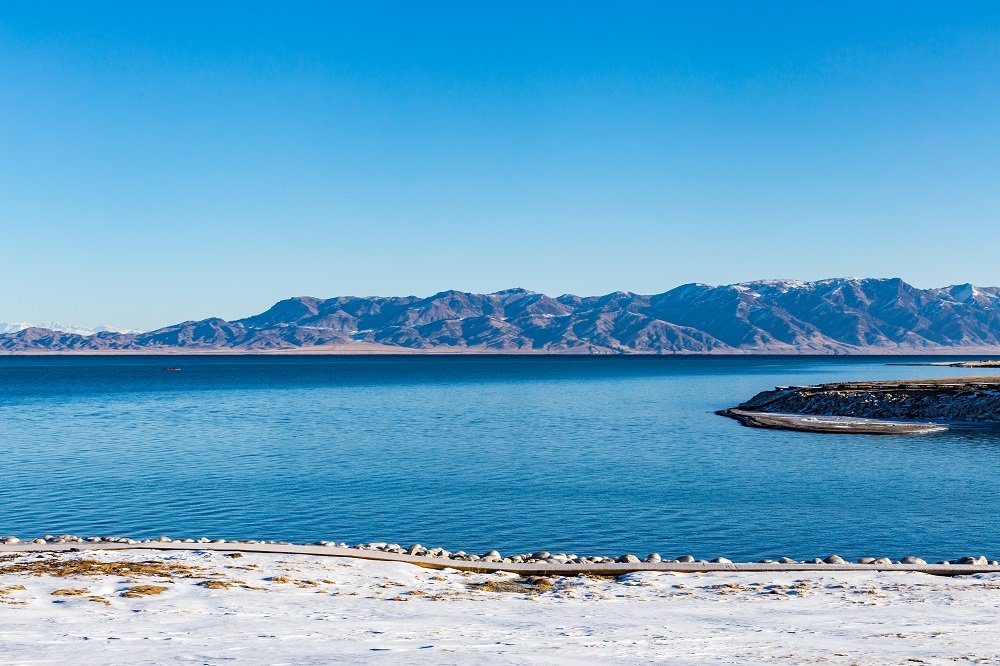
Sayram Lake is the highest and largest alpine lake in Xinjiang, known for its stunning beauty. It’s often referred to as the “Last Tear of the Atlantic” because it’s the final place where the Atlantic Ocean’s warm and humid air masses reach.
Sayram Lake resembles a sparkling sapphire nestled in a basin between the Western Tianshan Mountains. Surrounded by mountains, the lake’s waters reflect the sky, creating a breathtaking scene. In winter, the lake is covered in snow, and the contrast between the evergreen trees and the white snow makes for a picturesque view. During spring and summer, the vast grasslands around the lake are filled with blooming flowers, herds of cattle and sheep, and nomadic culture, creating a poetic landscape along the ancient Silk Road.
37. Karamay World Devil City

The World Devil City, also known as Urho Wind City, is located in Wuerhe District, Karamay City, Xinjiang. It’s characterized by its unique Yardang landforms formed by wind and rain erosion.
Karamay World Devil City is famous for its bizarre geological landscapes, unique wildlife, and the traditional Mongolian culture of the region. Its remote and desolate beauty attracts photographers and tourists from all over the world.
38. Tianshan Mysterious Grand Canyon

Tianshan Mysterious Grand Canyon is formed by red-brown mountains and is often referred to as “Keziliya” in the Uighur language, meaning “Red Rock.” It runs mainly in a north-south direction, with a slightly eastward bend at the end. The main canyon is about 2.7 kilometers long, with four tributary valleys, totaling about 3 kilometers in length.
The Tianshan Mysterious Grand Canyon was formed by millions of years of erosion from wind and rain, and it combines grandeur, danger, seclusion, tranquility, and mystique into one breathtaking experience.
39. Moon Bay
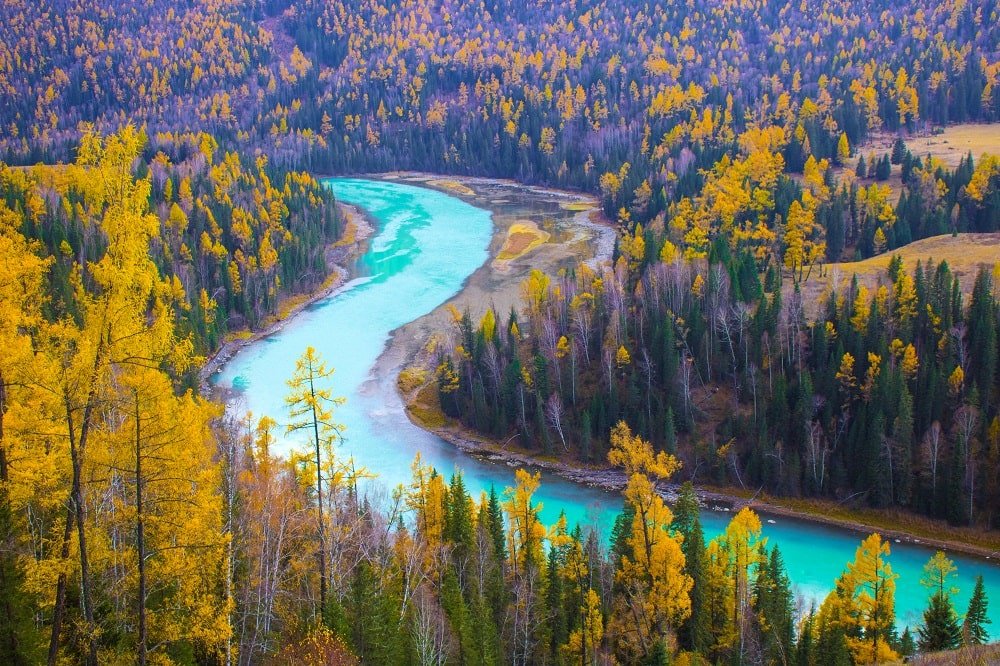
On the bed of the Kanas River, there are several crescent-shaped river bays formed by reverse “S” bends, known as “Moon Bay.” Moon Bay winds its way through the river valley, with calm waters that reflect like a mirror. Two sandbars resembling footprints, known as the “Footprints of the Immortals,” have formed within the upper and lower bays, adding to the uniqueness of the landscape.
Moon Bay is one of the famous Three Bays in Kanas, and due to differences in lakebed elevation and lighting conditions, the river waters of Moon Bay present magnificent and ever-changing colors. The observation deck on the wooden plank road is the best place for photography, making it a favorite spot for photography enthusiasts.
40. Cattle And Sheep Bazaar

Xinjiang not only offers beautiful landscapes but also delicious food and unique experiences. In Kashgar, there is an interesting livestock market that attracts many tourists for sightseeing and shopping.
Cattle And Sheep Bazaar primarily deals with the trading of cattle, sheep, camels, and mules. It’s the largest livestock and animal trading market in Kashgar and one of the biggest in southern Xinjiang and even Asia. It might not have grand architecture, but the smiles on people’s faces here are genuine, reflecting the region’s primitive and rugged charm.
These are just a few of the many captivating attractions Xinjiang has to offer, making it a destination that caters to a wide range of interests and travel preferences.
Conclusion
As we conclude our virtual tour of Xinjiang, we’ve barely scratched the surface of this extraordinary region’s beauty and wonder. Xinjiang’s diverse landscapes, from the heavenly Tian Shan Mountains to the enigmatic Sayram Lake, the surreal World Devil City to the mysterious Tianshan Grand Canyon, and the poetic Moon Bay to the bustling Niu Yang Big Bazaar, reveal a tapestry of natural and cultural richness that’s unlike any other. Whether you dream of exploring rugged terrains, witnessing stunning natural phenomena, or immersing yourself in vibrant local cultures, Xinjiang has it all. So, when you’re ready to embark on your next adventure, consider Xinjiang, a land that will leave an indelible mark on your heart and soul.



